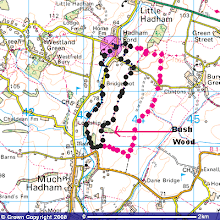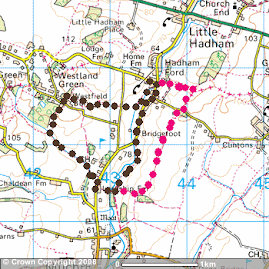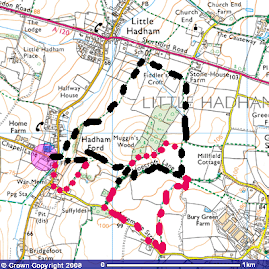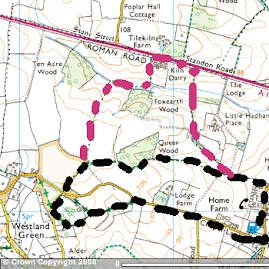Setting off at 7.15am for a day's birding along the North Norfolk Coast. I arrived in Wells for a coffee at 9.00 and then headed for Warham Greens between Wells and Stiffkey. A good migrant site, but not today and this area set the tone for the whole day. The fog was slowly clearing and the temperature was rising but still a sweater required. I wandered to the Metal Gibbert roundabout and back, noting regulars for this time of year. A hoped for ring ouzel didn't materialise but first chiffchaffs of the day were noted, along with curlew, redshank, brent geese, chaffinches etc. I planned on trying for photos that depicted birds in spring: a few worked but many didn't!
 |
| Black headed gull in early morning light |
 |
| Brent goose |
 |
| Linnet, they followed me throughout the day! |
 |
| chiffchaff in hawthorn |
 |
| Chiffchaff on Alexanders, a plant that is taking over the whole of North Norfolk! |
 |
| Another linnet |
 |
| Smart springtime chaffinch |
 |
| Dunnock |
 |
| Brent geese put up by Marsh harrier |
From here, I headed to Kelling Water meadows where I met a couple that informed me that very little was about. Common sandpiper, stonechat, 4 avocet, wheatear, gadwall, shoveler, redshank, mallard, wigeon and shelduck seemed good to me, coming from landlocked Hertfordshire. As I returned to the car, small tortoiseshell and peacock butterflies were an indication of the temperature increase (necessitating a sweater removal) and several blackcaps were singing, but not performing for the camera.
 |
| Male kestrel over Kelling Hard |
 |
| Another linnet! |
 |
| Small tortoiseshell |
 |
| Shelduck with a wigeon pair on the water |
Back to the car and up to Kelling Heath. I arrived at the car park and asked a birder if the wood lark were about. "Over there 20 minutes ago," he replied. I knew that a pair were near the metal gate at the car park and after 10 minutes one flew over, typically disappearing from view before a photo. However, several willow warblers could be heard and I tracked one down. It refused to emerge for a decent photo, this, sadly was the best I could manage.
 |
| male willow warbler |
I then thought it was time for a shot of caffiene, so off to the Visitors' Centre at Cley. A double espresso and Bakewell flapjack fired me up again and even better! I searched through my wallet for my membership card to the Norfolk Wildlife Trust and, in the process, came across some bank notes I had put away during our Sri Lankan trip. I had looked for these after we had landed at Heathrow and then forgotten. A most welcome £55.00!!
A wander to the hides gave views of a few new birds, black tailed godwits, knot, dunlin, but nothing too noteworthy.
 |
| Just great plumage |
 |
| Lapwing that is very shy! |
 |
| 2 Black tailed godwits showing differences as they come into breeding plumage |
 |
| Knot, not a frequent visitor to the scrape from Daukes Hide |
 |
| Black tailed godwit |
 |
| Avocet |
Following this excursion I drove to the beach car park for a sea watch but nothing was moving apart from a selection of the gulls, so off to Holkham and a drive down Lady Anne's Drive. Nothing here, so on to Burnham Norton for a wander to the coastal footpath and back. 2 distant garganey were pleasing, little egrets, tufted duck and another marsh harrier.
 |
| Meadow pipit, a pleasing shot |
 |
| A very high overhead marsh harrier |
 |
| Little egret |
 |
| Pair of tufties |
Time was beginning to run out, so off to Choseley Drying Barns, but not before a stop at Burnham Overy Staithe where I added turnstone to the list for the day.
At Choseley, yellowhammer and red legged partridge made the list before I had got out of the car. In the distance, another male marsh harrier, plenty of partridge, both rlp and grey along with 8 brown hares in one field.
 |
| Always good to see a brown hare |
After this; Titchwell RSPB Reserve and just in time to catch the cafe for one of their brilliant Bakewell Tarts. On to the reserve as everyone was leaving. Now gone 5pm but plenty of light left. 2 Mediterranean gulls were the highlight on the Fresh Marsh whilst from the beach: 100's of common scoter, long tailed duck and 3 great crested grebe. As I scoped the horizon, 2 red breasted mergansers were heading into The Wash for the night. Grey plovers were noted on the salt marsh. Just a peaceful, relaxing place to be as the sun sank over Thornham Marsh.
As I wandered back to the now empty car park both a nuthatch and another blackcap sang due to my departure.
 |
| 2 Med gulls a long way off the footpath. |
 |
| Shovelers |
 |
| Teal drake |
 |
| redshank |
 |
| feeding (very noisily) knot |
 |
| Brent goose |
 |
| Avocet |
 |
| Blackcap near Titchwell car park |
A stop at Burnham Deepdale for petrol and drink and then the drive home, stopping for some food before arriving home 14 hours after leaving. A wonderful day, my first in Norfolk this year. Shame I didn't have time for Holme and Hunstanton cliffs to add to the 78 species noted. No cormorant, grey heron or Egyptian goose seen!
As always, I keep the best shots for my RSPB, Nat Hist and Bird Club presentations, so most of these are ones I am happy to share.
























































































































